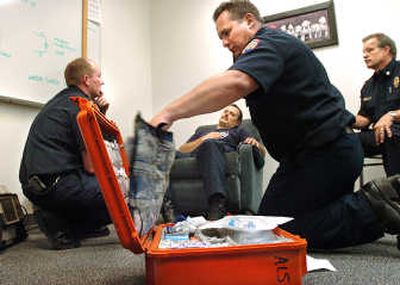More than fighting fires

By 2 p.m. on a recent Tuesday, the firefighters at Spokane Valley Fire Department’s Station 7 had already helped a person who was having an asthma attack, taken a sick woman to the hospital, helped a patient who had fallen and needed help getting up, and cleaned up a gasoline spill.
But, there wasn’t a fire in sight.
“When you think of the Fire Department, you think of fires, but what we get most of are emergency calls,” said the department’s emergency medical services chief, Randy Olson.
Eighty percent of the department’s calls are for emergency medical services, up more than 25 percent this year, according to the department’s quarterly report. Olson said increasing demand for EMS services is a trend facing firefighters across the country. Fire Chief Mike Thompson attributes the increase to an aging population and residents who lack health insurance who use the hospital and emergency services as an alternative to a medical plan.
“We’ve seen more and more of it,” he said. “They use the system, get transported, and emergency services absorbs the costs.”
The number of certified SVFD paramedics will grow from 37 to 40 by the end of the year, reflecting the increase in EMS calls, Olson said.
He said typical calls can range anywhere from dog bites, lacerations, inhaling fumes from cleaning solutions, a twisted ankle, chest pain, cardiac arrest or difficulty breathing.
There are two levels of care the Fire Department provides. The first is Basic Life Support, for emergencies that are not life-threatening, such as falling down, a broken bone or a cut. BLS calls do not require a paramedic since all firefighters are emergency medical technicians and trained to handle these runs. These calls make up about half of all calls and have increased by 23.4 percent since last year.
The other half of the calls are Advanced Life Support calls, which are considered life-threatening and do require a paramedic. Some ALS cases include difficulty breathing, chest pains, diabetics and strokes. These calls are up 4.8 percent.
Many calls of both levels come from nursing homes and retirement communities, Olson said.
“I believe they go once a day to one of the retirement places in the area,” he said of Station 1, which along with stations 6 and 7, is among the busiest stations.
Currently, five out of the 10 stations always have at least one paramedic every day, Thompson said. Some stations respond to 12 to 15 calls a day.
“Sometimes they don’t have time to eat,” Thompson said.
Paramedic Darrell Core, who has been with the department for eight years, became a paramedic five years ago. He has defiantly noticed the increase for medical services.
“They are desperate for paramedics all over the place,” he said. When he became certified, he said he had offers from other areas but decided to stay in Spokane Valley because of the staff and the progressive care offered.
“These guys are great,” he said of his fellow firefighters. Unlike other counties, in Spokane County Core doesn’t need to phone in to the hospital before performing some of the more basic care, such as starting an IV, making it more efficient for him to treat a patient.
“Sometimes we won’t know how to treat a patient and we’ll bring them to the hospital,” he said. “You do your best to guess.”
One some days he’ll see stubbed toes, or just someone who needs a ride to the hospital, but he knows it’s part of the job description.
Each run, which can last for half an hour to two hours, depending on the severity of the case, can take an emotional toll.
“It’s not just picking up a patient and leaving, it’s supporting the patient and their family,” he said.
Ray Moeckel, firefighter at Station 1, has been with the department for five years and recently decided to become a paramedic. He started his field internship in July. In the last six weeks, Moeckel has seen 62 patients, but “that’s what we’re here for,” he said. Moeckel will have to see 130 patient transports, in which he actually escorts the patient to the hospital, plus at least 460 hours of patient contact to be certified. After certification paramedics must complete monthly training to stay certified.
Thompson said the department will continue to train more firefighters, so that every station will have at least one paramedic at all times. The goal will take five to 10 years to achieve, but it is necessary, he said.
“We try to have people. If something is life-threatening, you need a lot of people,” Thompson said, who added that he doesn’t see the EMS calls slowing or even stabilizing for a while.
Olson calls the department an “at-risk agency,” that stopped exclusively fighting fires 30 years ago. Many new firefighters don’t know what they are getting into, he said.
“If you think you are going to be fighting fires, you are sadly mistaken,” Olson said. “If you don’t like helping grandma back to bed, or assisting in a cardiac arrest, you’d best find another profession.”